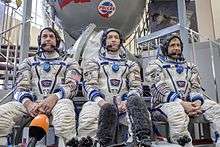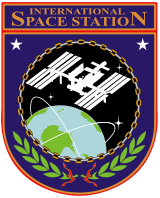Soyuz MS-02
.jpg) Soyuz MS-02 during preflight checks | |
| Operator | Roskosmos |
|---|---|
| COSPAR ID | 2016-063A |
| SATCAT no. | 41820 |
| Mission duration | 173 days 3 hours 16 minutes 21 seconds[1] |
| Distance travelled | 118 million kilometers[1] |
| Orbits completed | 2,768[1] |
| Spacecraft properties | |
| Spacecraft type | Soyuz-MS 11F747 |
| Manufacturer | RKK Energia |
| Crew | |
| Crew size | 3 |
| Members |
Sergey Ryzhikov Andrei Borisenko Robert Kimbrough |
| Callsign | Favor |
| Start of mission | |
| Launch date | 19 October 2016 08:05 UTC |
| Rocket | Soyuz-FG |
| Launch site | Baikonur 31/6 |
| End of mission | |
| Landing date | 10 April 2017 11:20 UTC |
| Landing site | Kazakhstan |
| Orbital parameters | |
| Reference system | Geocentric |
| Regime | Low Earth |
| Inclination | 51.6° |
| Docking with ISS | |
| Docking port | Poisk zenith |
| Docking date | 21 October 2016 09:52 UTC |
| Undocking date | 10 April 2017 07:57 UTC |
|
 (l-r) Kimbrough, Ryzhikov and Borisenko Soyuz programme (Manned missions) | |
Soyuz MS-02 was a 2016 Soyuz spaceflight that was planned for a 23 September 2016 launch, but because of technical difficulties it launched on 19 October 2016.[2] It transported three members of the Expedition 49 crew to orbit and docked with the International Space Station. MS-02 was the 131st flight of a Soyuz spacecraft. The crew consists of a Russian commander and flight engineer, as well as an American flight engineer.[3][4] MS-02 docked with (Poisk (MRM-2) module on Friday, October 21, 2016.[5]
MS-02 returned to Earth on Monday, April 10, 2017.[6] During its descent, the capsule was partially depressurized when the main parachute deployed. The landing occurred at 11:20 UTC. The total flight duration was 173 days.
Partial Depressurization
During the final stage of its descent, Soyuz MS-02 suffered a partial depressurization[7] about eight kilometers above the ground. When the main parachute was deployed, a buckle that was part of the deployment system struck a welding seam, partially depressurizing the capsule. The depressurization did not put the crew in danger as they were at a relatively safe height within the atmosphere when it occurred. Russian officials believe that the way the parachute was packed caused the buckle to strike the capsule.
Crew
| Position[8] | Crew Member | |
|---|---|---|
| Commander | Expedition 49 First spaceflight | |
| Flight Engineer 1 | Expedition 49 Second spaceflight | |
| Flight Engineer 2 | Expedition 49 Second spaceflight | |
Backup crew
| Position[9] | Crew Member | |
|---|---|---|
| Commander | ||
| Flight Engineer 1 | ||
| Flight Engineer 2 | ||
References
- 1 2 3 "Afternoon Soyuz Touchdown Caps Half-Year Space Mission for Russian-American Crew Trio". Spaceflight101.com. April 10, 2017. Retrieved 2017-04-10.
- ↑ "Soyuz spacecraft with 3-man crew blasts off to Intl Space Station". RT News. 19 October 2016. Retrieved 19 October 2016.
- ↑ Sarah Lewin (19 October 2016). "Liftoff! Soyuz Rocket Launches US-Russian Space Station Crew Into Orbit". Space.com. Retrieved 19 October 2016.
- ↑ "Soyuz MS-02 spacecraft docks with Expedition 49/50 crew | NASASpaceFlight.com". www.nasaspaceflight.com. Retrieved 2016-10-31.
- ↑ "Soyuz MS-02 spacecraft docks with Expedition 49/50 crew - NASASpaceFlight.com". www.nasaspaceflight.com.
- ↑ Garcia, Mark (2015-02-12). "Expedition 50". NASA. Retrieved 2017-03-16.
- ↑ "Soyuz capsule suffered partial depressurization during April landing - SpaceNews.com". SpaceNews.com. 2017-10-17. Retrieved 2018-02-27.
- ↑ Планируемые полёты (in Russian). astronaut.ru. Retrieved 13 March 2014.
- ↑ astronaut.ru (2015). "Планируемые полёты" (in Russian).


